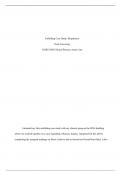Multiple team membership
MTM and the individual
Date: November 6th, 2020
Word count: 2518
Grade: 7
, Introduction
Project workers often work on parallel projects, where multiple ‘patient care teams’ are
taken on by healthcare professionals, and knowledge workers are placed in several R&D groups
simultaneously (Van de Brake et al., 2019). Companies aim to increase their productivity
through enhancement of efficiency, as well as their learning on the basis of knowledge transfer.
In order to do so, firms take on the approach of multiple team membership (Milgrom & Roberts,
1992). Multiple team membership refers to the concept of individual employees participating in
two or more teams simultaneously, meaning that they have to balance different responsibilities of
these projects (Van de Brake et al., 2020).
So far, several studies have addressed positive and negative outcomes of MTM for both
individuals and teams. Concerning the positive effects, MTM provides a great atmosphere for
learning and encourages productive relationships between collaborative groups (Matthews,
Whittaker, Moran, Helesley, & Judge, 2011). In addition, Chan (2014) reported that MTM is
positively related to team performance and enhances individual innovative performance. As for
the negatives, research has shown that MTM can lead to increased stress, and absenteeism (van
de Brake et al., 2019), or decreased job engagement (Pluut, Flestea & Curses, 2014).
However, few studies tried to explain the conditions under which MTM is associated
with positive or negative impacts, O’Leary et al., (2011) discuss several effects of MTM and
conclude in their study that both productivity and learning can be enhanced through MTM when
cost and benefits are well managed. Moreover, Van der Brake et al, (2020) argued that MTM
increases the size of information sharing networks and thus enhances the performance across
teams, they also argued that this depends on the characteristics of these networks.
Furthermore, MTM is characterized as a complex work practice with very high demands
(Kauppila, 2014). According to Mortensen (2014), these high demands boil down to the need for
the employee to allocate their time between teams and the shift of attention from one task to
another. Part of the confusion that results from MTM is role ambiguity, which has been linked to
decreased performance and increased absenteeism (van de Brake et al, 2019). In their study,
Pluut et al. (2014) found that the job demands and resources that were associated with MTM
lead to increased levels of job strain and decreased levels of engagement. In addition, Bakker &
Demerouti (2007) argue that job strain accumulated through high job demands leads to
exhaustion, further strengthening the effect of MTM on an individual’s well-being.
2
MTM and the individual
Date: November 6th, 2020
Word count: 2518
Grade: 7
, Introduction
Project workers often work on parallel projects, where multiple ‘patient care teams’ are
taken on by healthcare professionals, and knowledge workers are placed in several R&D groups
simultaneously (Van de Brake et al., 2019). Companies aim to increase their productivity
through enhancement of efficiency, as well as their learning on the basis of knowledge transfer.
In order to do so, firms take on the approach of multiple team membership (Milgrom & Roberts,
1992). Multiple team membership refers to the concept of individual employees participating in
two or more teams simultaneously, meaning that they have to balance different responsibilities of
these projects (Van de Brake et al., 2020).
So far, several studies have addressed positive and negative outcomes of MTM for both
individuals and teams. Concerning the positive effects, MTM provides a great atmosphere for
learning and encourages productive relationships between collaborative groups (Matthews,
Whittaker, Moran, Helesley, & Judge, 2011). In addition, Chan (2014) reported that MTM is
positively related to team performance and enhances individual innovative performance. As for
the negatives, research has shown that MTM can lead to increased stress, and absenteeism (van
de Brake et al., 2019), or decreased job engagement (Pluut, Flestea & Curses, 2014).
However, few studies tried to explain the conditions under which MTM is associated
with positive or negative impacts, O’Leary et al., (2011) discuss several effects of MTM and
conclude in their study that both productivity and learning can be enhanced through MTM when
cost and benefits are well managed. Moreover, Van der Brake et al, (2020) argued that MTM
increases the size of information sharing networks and thus enhances the performance across
teams, they also argued that this depends on the characteristics of these networks.
Furthermore, MTM is characterized as a complex work practice with very high demands
(Kauppila, 2014). According to Mortensen (2014), these high demands boil down to the need for
the employee to allocate their time between teams and the shift of attention from one task to
another. Part of the confusion that results from MTM is role ambiguity, which has been linked to
decreased performance and increased absenteeism (van de Brake et al, 2019). In their study,
Pluut et al. (2014) found that the job demands and resources that were associated with MTM
lead to increased levels of job strain and decreased levels of engagement. In addition, Bakker &
Demerouti (2007) argue that job strain accumulated through high job demands leads to
exhaustion, further strengthening the effect of MTM on an individual’s well-being.
2











